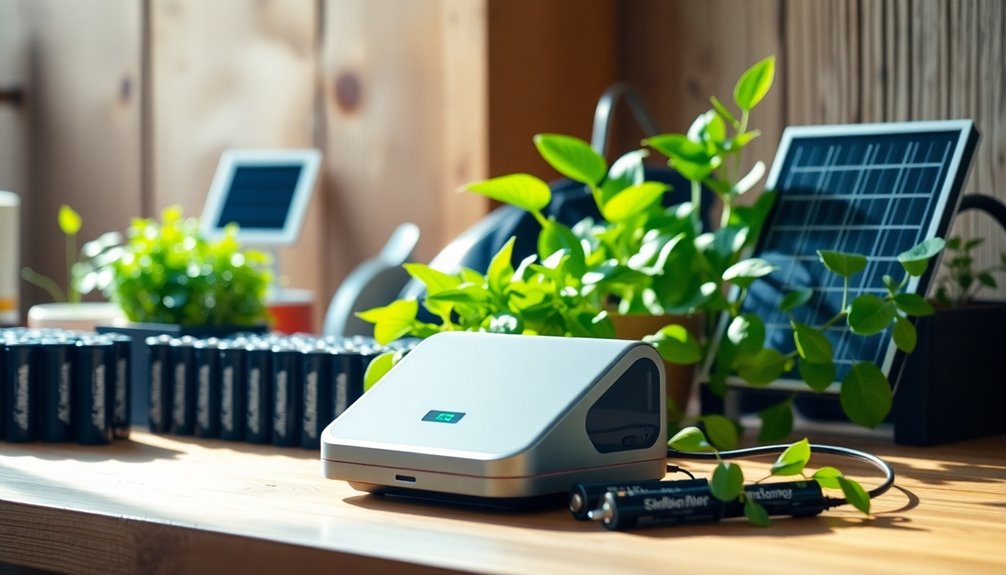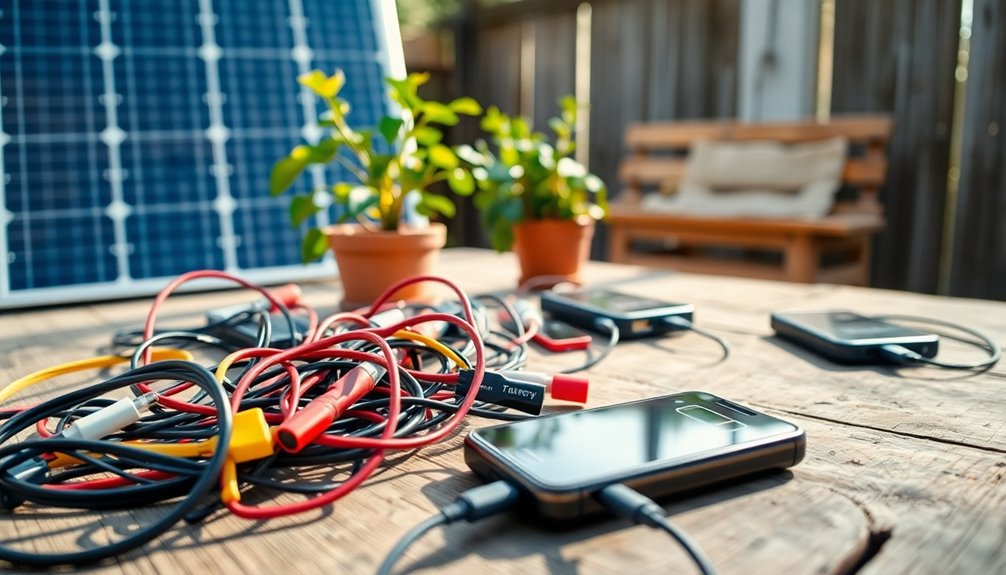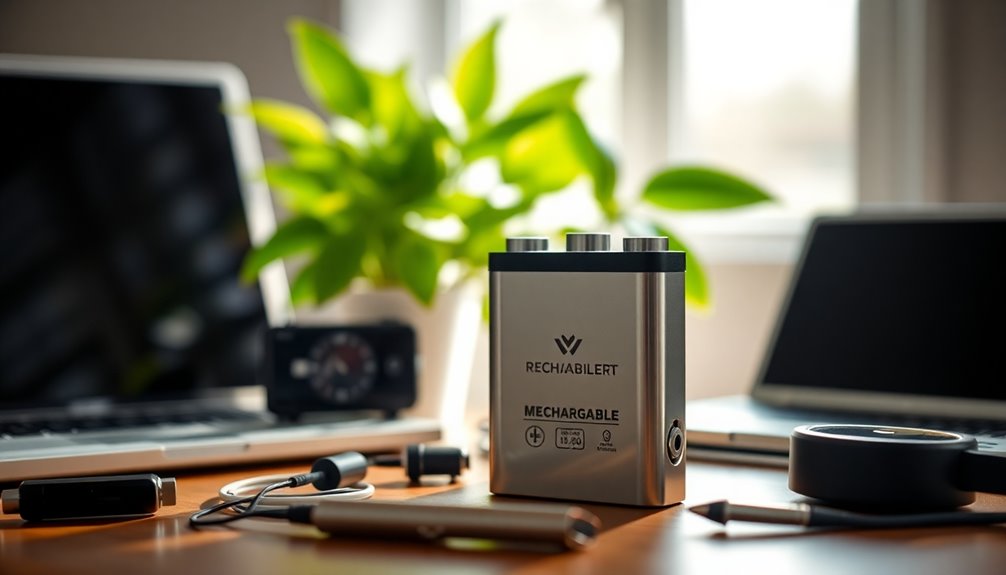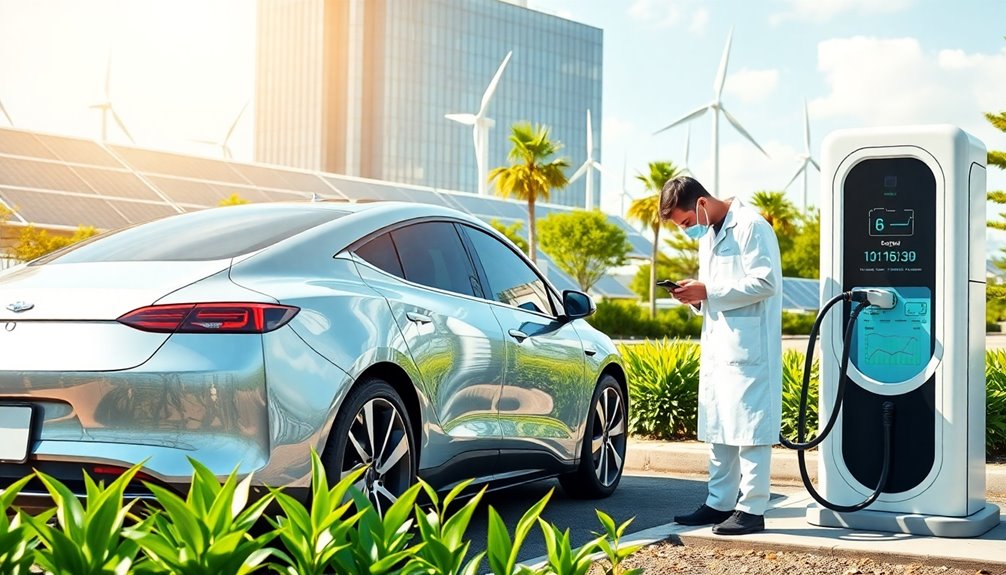Recharging batteries is a smart way to save money and protect the planet. Start by choosing rechargeable options like Lithium-Ion or Nickel-Metal Hydride, which can last for up to 500 charges and reduce waste considerably. Charge during off-peak hours to cut carbon emissions and save up to 80% on your electricity bill. Avoid overheating by keeping your batteries cool and maintaining charge levels between 20% and 80%. By adopting these practices, you'll not only extend battery life but also contribute to a more sustainable future. You might be surprised to learn more about the latest innovations in battery technology.
Key Takeaways
- Charge batteries during off-peak hours to save up to 80% on electricity bills and reduce carbon emissions significantly.
- Use smart charging stations that optimize energy consumption based on renewable energy availability for increased efficiency.
- Maintain battery charge levels between 20% and 80% to extend battery lifespan and prevent overheating.
- Keep batteries out of direct sunlight while charging to avoid excessive heat and potential safety hazards.
- Invest in rechargeable batteries, as they can be charged up to 500 times, minimizing landfill waste and promoting sustainability.
Understanding Rechargeable Batteries

Rechargeable batteries are a game changer for anyone looking to reduce waste and save money. Utilizing advanced battery technology, these batteries undergo a reversible chemical reaction, allowing you to recharge and reuse them hundreds, even thousands of times.
By opting for rechargeable batteries, you markedly cut down on landfill waste compared to single-use options, positively impacting the environment. Common types like Lithium-Ion and Nickel-Metal Hydride offer various capacities for different applications.
While the upfront cost may seem high, the long-term savings are undeniable; you'll notice fewer replacements and lower energy consumption over time. Choosing rechargeable batteries not only helps you save money but also contributes to a sustainable future, minimizing harmful chemical leakage and enhancing your environmental impact.
Sustainable Charging Practices

When you charge your batteries during off-peak hours, you can cut carbon emissions considerably while saving on energy costs.
By harnessing renewable energy sources like solar or wind power, you'll further reduce your environmental impact and reliance on fossil fuels.
Adopting these sustainable practices not only benefits the planet, but also enhances the efficiency and longevity of your batteries.
Renewable Energy Sources
Utilizing renewable energy sources for charging not only helps you reduce your carbon footprint but also promotes a sustainable lifestyle.
By harnessing solar energy through personal solar panels, you can efficiently charge your rechargeable batteries while saving on electricity costs. This smart investment contributes to a greener planet, allowing you to store energy for later use.
Additionally, integrating renewable energy systems with electric vehicles creates a bi-directional energy flow, minimizing greenhouse gas emissions. Heat pumps represent another innovative application of renewable energy that can enhance energy efficiency in various systems.
Smart charging stations further optimize your electricity usage by aligning charging times with renewable energy availability, enhancing overall grid efficiency.
Embracing these practices not only supports your financial goals but also plays an essential role in fostering a sustainable future for everyone.
Off-Peak Charging Benefits
Charging your devices during off-peak hours offers significant advantages for both your wallet and the environment. By utilizing off-peak charging, you can save money on your electricity bills, with some utility companies providing rates that cut costs by up to 80%.
This practice not only reduces your expenses but also helps reduce reliance on fossil fuels, cutting carbon emissions by up to 50%. Additionally, charging during these times enhances energy efficiency and promotes a more stable electrical grid.
It also extends the lifespan of your rechargeable batteries by minimizing wear and tear from overheating. Implementing smart charging technologies can further optimize your charging schedule, ensuring you reap all these benefits effortlessly.
Embrace off-peak charging today!
Smart Charging Technologies

As electric vehicle adoption surges, smart charging technologies have emerged as essential tools for optimizing battery recharge processes.
By utilizing real-time data algorithms, these systems enhance energy consumption efficiency and support the integration of renewable energy sources.
You can experience significant benefits, such as:
- Lower carbon emissions by charging during high renewable energy availability, achieving reductions of up to 50%.
- Up to 80% reductions in electricity bills through off-peak charging practices.
- Advanced monitoring systems that help you adjust charging habits for improved efficiency.
Battery Management Tips

Smart charging technologies have paved the way for more efficient battery use, but proper battery management is just as important for maximizing performance and longevity.
To extend your rechargeable batteries' battery life, keep charge levels between 20% and 80%. Avoid complete discharges, as they can lead to significant capacity loss. Always disconnect your battery charger once full to prevent overcharging, which diminishes capacity over time.
Store batteries at around 15°C (59°F) to protect them from extreme temperatures that can shorten their lifespan. Use manufacturer-recommended chargers and never mix different types or brands in the same charger.
Finally, monitor your charging devices closely to mitigate fire risks and guarantee proper ventilation to prevent overheating. These steps are key to saving money and enhancing battery longevity.
Environmental Benefits

- Less landfill waste: Rechargeable batteries can be used for up to 500 charges, decreasing the 20 billion single-use batteries that end up in landfills annually.
- Reduced toxic metals: Prevent the leakage of toxic metals like mercury and lead, which often occurs with disposable batteries.
- Lower carbon footprint: Rechargeable batteries notably minimize the environmental impact associated with battery production.
Additionally, proper recycling of rechargeable batteries helps recover valuable materials while preventing soil and water contamination. Moreover, transitioning to renewable energy technologies can further enhance the sustainability of battery production and disposal processes.
Economic Benefits

Many consumers find that opting for rechargeable batteries can lead to significant savings over time.
By investing in rechargeable batteries, you can save up to $1,000 over their lifetime compared to disposable ones, which require constant replacements. While the initial purchase might be higher, the cost savings quickly add up as you reduce regular purchases.
Using solar-powered chargers can additionally help you save money by cutting electricity costs by up to 80% when used during off-peak hours.
Moreover, rechargeable batteries reduce waste, leading to lower disposal costs and potential savings through recycling programs. Additionally, adopting energy-efficient technology can further enhance your savings and contribute to a more sustainable lifestyle.
Challenges in Charging

When charging your batteries, you need to be aware of the risks of overcharging, which can drastically shorten their lifespan.
Also, keep an eye on the temperature; extreme conditions can cause serious damage.
Overcharging Risks
Although modern chargers often include safety features, overcharging batteries remains a significant risk that can lead to serious consequences.
When you overcharge rechargeable lithium-ion batteries, you might face:
- Significant capacity loss, reducing lifespan by up to 40%
- Increased risk of overheating or fire hazards
- Deterioration of battery health due to trickle charging
Even with smart technology that halts charging at a full charge, keeping devices plugged in can still harm battery longevity.
To maintain peak battery health, unplug your devices once they're fully charged and aim to keep battery levels between 20% and 80%.
Temperature Sensitivity
Temperature plays an essential role in battery performance, and understanding its impact can help you charge your devices more effectively. Rechargeable batteries thrive at room temperature, ideally around 15°C (59°F), to minimize capacity loss.
Extreme temperatures—both hot and cold—can greatly shorten battery lifespan. Charging in high temperatures risks overheating, leading to potential safety hazards like fires.
To promote ideal longevity, keep your battery charge levels between 20% and 80%. Avoid fully charging your battery in heat, as this can degrade its components.
Additionally, always keep batteries out of direct sunlight while charging to prevent excessive heat that harms performance. By being mindful of temperature sensitivity, you can enhance your battery's health and efficiency.
Future Trends in Sustainability

As the world shifts toward greener energy solutions, future trends in sustainability are rapidly evolving, particularly in the domain of battery recharging.
You'll likely see an increase in smart charging stations and renewable energy power sources, optimizing how we use rechargeable batteries.
Key trends include:
- Vehicle-to-Grid (V2G) technology that reduces carbon emissions by allowing electric vehicles to discharge energy back to the grid.
- Solar-powered charging stations in public areas, minimizing reliance on fossil fuels.
- Smart charging practices that can cut carbon emissions by up to 50% during off-peak hours.
These advancements in battery types and energy density will certainly contribute to a more sustainable energy landscape, making it easier for you to adopt eco-friendly solutions. Additionally, the integration of energy-efficient systems in homes, such as heat pumps, can further enhance overall sustainability efforts.
Frequently Asked Questions
Are Rechargeable Batteries Better for the Planet?
Absolutely, rechargeable batteries are better for the planet. They cut down on waste since you can use them for up to 500 charges, reducing the number of single-use batteries that end up in landfills.
Plus, they minimize harmful chemical leakage and lower the energy demand for producing new batteries. By choosing rechargeables, you're not only saving money but also contributing to a cleaner, greener environment.
It's a win-win for you and the Earth!
What Is the Golden Rule of Battery Charging?
Did you know that overcharging can reduce your battery's lifespan by up to 50%?
The golden rule of battery charging is to avoid overcharging. Keep your charge level between 20% and 80% to maintain peak performance and longevity.
Use manufacturer-recommended chargers to guarantee safety and compatibility. Always monitor your devices while charging, as unattended ones can pose fire risks.
Finally, store batteries at around 40% in a cool, dry place to minimize self-discharge.
What Is the Most Efficient Way to Charge a Battery?
To charge a battery efficiently, keep it between 20% and 80% charged, avoiding full discharges or overcharging.
Use a smart charger that stops charging when the battery's full to prevent overheating.
Charge your device at room temperature, ideally between 15°C and 25°C, for best results.
Additionally, consider charging during off-peak hours to save on energy costs and reduce carbon emissions.
Regularly check your charging cycles to maintain battery health.
What Batteries Are a Good Way to Save Money and Reduce Waste?
Think of rechargeable batteries as your eco-friendly sidekick, always ready for action.
If you want to save money and reduce waste, go for Nickel-Metal Hydride (NiMH) or Lithium-Ion (Li-ion) batteries. They can be recharged hundreds of times, cutting down on landfill waste.
Investing in brands like Eneloop or Energizer not only saves you cash but also helps keep toxic metals out of our planet. It's a win-win for your wallet and the environment!
Conclusion
By adopting sustainable charging practices, you're not just saving money but also contributing to a healthier planet. For instance, consider a family that switched to rechargeable batteries for their devices. They found they saved over $200 annually while reducing their household waste. Embrace smart charging technologies and battery management tips, and you'll see both your wallet and the environment benefit. Start making small changes today, and watch the positive impact grow!










